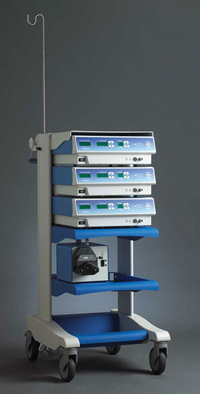Radio Frequency Ablation
Interstital Techniques for the Destruction of Liver Tumours
There are other methods for treating secondary liver cancer that may not be surgically removable.
The Radio Frequency Ablator (RITA)
 |
| Radio Frequency Ablator (RITA) |
Destruction of small liver tumours by radio frequency ablation (RFA) may be carried out using a small probe placed percutaneously (through the skin) under ultrasound guidance or placed under direct vision using the laparoscopic (keyhole surgery) approach. This technique uses radio frequency waves to generate heat within the tumour nodule thus denaturing the protein elements of the tumour. Over a period of weeks the lesion created in the liver slowly becomes absorbed into the body. At present this technique is offered to patients who are surgically inoperable or those who are medically unfit for major liver surgery. This is an exciting new technique still being evaluated, but potentially this may increase the number of patients who may be offered surgery plus RFA.
Radioactive Microspheres
By labelling tiny microspheres with radio-active isotopes and then injecting these microspheres selectively into branches of the hepatic artery to the parts of the liver containing tumour modules, diseased portions of the liver may be effectively treated. Occasionally a complete response may occur, but more often the tumour may be reduced in size (down-staged) and an inoperable patient may then be rendered operable.
Microwave (Microwave Ablation Generator)
 |
| Microwave Ablation Generator |
Tumours that cannot be surgically removed may be treated by microware energy so as to destroy them. This treatment may be used to increase the numbers of patients who could undergo surgical removal where surgery is limited by one or more inaccessible nodules. By removing the bulk of the disease surgically and then microwaving the remaining nodules patients may be offered the prospect of long term remission. This treatment can be used at open surgery and laparoscopically. It could also be used percutaneously.